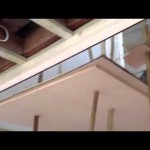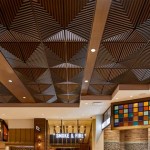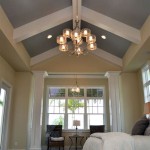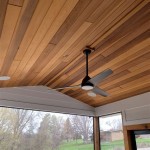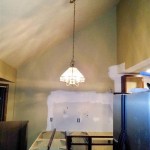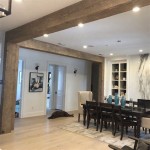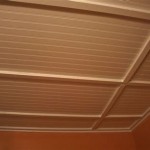How to Hang a Ceiling Fan in a Vaulted Ceiling
Installing a ceiling fan can significantly improve air circulation and energy efficiency in a room. When dealing with a vaulted ceiling, however, the installation process requires specific adaptations and considerations. This article provides a comprehensive guide to hanging a ceiling fan in a vaulted ceiling, covering the necessary preparations, tools, and step-by-step instructions to ensure a safe and effective installation.
Before commencing the installation, understanding the specific challenges presented by vaulted ceilings is crucial. Unlike standard flat ceilings, vaulted ceilings have an angled surface, necessitating the use of specialized mounting hardware to ensure the fan hangs level and operates correctly. Furthermore, the increased height of vaulted ceilings often requires the use of longer downrods to position the fan at an optimal distance from the floor for effective air circulation.
Safety is paramount throughout the entire installation process. Disconnecting the power supply to the circuit before starting any electrical work is non-negotiable. This prevents the risk of electric shock and ensures a safe working environment. Additionally, it is essential to use appropriate personal protective equipment, such as safety glasses and gloves, to protect against potential hazards.
Key Point 1: Preparation and Assessment
The initial phase of hanging a ceiling fan in a vaulted ceiling involves thorough preparation and assessment. This includes evaluating the existing electrical infrastructure, selecting the appropriate fan and mounting hardware, and gathering the necessary tools.
First, the existing electrical wiring and junction box must be assessed. The junction box's capacity to support the weight and motion of the ceiling fan must be verified. For vaulted ceilings, a fan-rated junction box is crucial. These boxes are specifically designed to withstand the dynamic forces exerted by a rotating ceiling fan. If the existing junction box is not fan-rated, it must be replaced with a suitable one before proceeding. Furthermore, the wiring should be inspected for any signs of damage or deterioration. If any issues are detected, a qualified electrician should be consulted to address them.
Next, the selection of the ceiling fan itself is a critical decision. The size of the room and the pitch of the vaulted ceiling should be taken into account when choosing a fan. Larger rooms typically require fans with longer blades to effectively circulate air. Additionally, the fan's features, such as lighting options and remote control functionality, should be considered based on individual preferences.
The mounting hardware is perhaps the most important aspect of the preparation phase when dealing with vaulted ceilings. A downrod is almost always required. The length of the downrod is determined by the height of the ceiling and the desired distance between the fan blades and the floor. Generally, a distance of 7 to 9 feet between the blades and the floor is recommended. A sloped ceiling adapter is mandatory for vaulted ceilings. This adapter allows the fan to hang level despite the angled surface of the ceiling. These adapters come in various angles to accommodate different ceiling pitches. Ensuring the adapter angle matches or exceeds the ceiling pitch is essential for a proper installation.
Finally, the necessary tools should be gathered. These typically include a voltage tester, wire stripper, wire connectors, screwdriver set (Phillips and flathead), adjustable wrench, measuring tape, level, drill with appropriate drill bits, and a ladder suitable for reaching the ceiling. Having all the necessary tools readily available streamlines the installation process and minimizes delays.
Key Point 2: Installation Process
With the preparation complete, the next step is the actual installation of the ceiling fan. This involves mounting the bracket and downrod assembly, wiring the fan, and attaching the fan blades.
The first step is to turn off the power at the breaker box. Test the wires with a non-contact voltage tester to confirm the power is off. Mount the sloped ceiling adapter to the fan-rated junction box using appropriate screws. Ensure the adapter is securely fastened to the junction box to prevent any movement or instability. Connect the downrod to the sloped ceiling adapter. Typically, the adapter will have a ball joint that the downrod attaches to. Ensure the downrod is properly secured using the included hardware, usually a pin or set screw. The sloped ceiling adapter ensures that, even attached to an angled surface, the downrod hangs perfectly vertically.
Next, carefully lift the fan motor assembly and insert the downrod through the canopy. Connect the wiring from the fan motor to the house wiring according to the fan manufacturer's instructions. Typically, this involves connecting the black (hot) wire, the white (neutral) wire, and the green (ground) wire using wire connectors. Double-check that all connections are secure and that no bare wires are exposed. Incorrect wiring can result in malfunction and safety hazards.
Slide the canopy up to cover the mounting bracket and secure it in place using the provided screws. This conceals the wiring and provides a finished appearance. Install the fan blades according to the manufacturer's instructions. Each blade should be securely attached to the fan motor assembly using screws. Ensure that all blades are properly balanced to prevent wobble during operation. Wobbling decreases air circulation and can indicate a critical installation flaw.
If the fan includes a light kit, install it according to the manufacturer's instructions. This typically involves connecting the light kit wiring to the fan motor wiring and attaching the light fixture to the fan motor assembly. Ensure that the light bulbs are properly installed and that all connections are secure.
Key Point 3: Testing and Troubleshooting
After the installation is complete, it is essential to test the fan to ensure it is functioning correctly. This includes testing the fan motor, the light kit (if applicable), and the remote control (if included). If any issues are detected, troubleshooting steps should be taken to identify and resolve them.
Turn the power back on at the breaker box. Test the fan motor by turning it on at different speeds. Verify that the fan blades are rotating smoothly and without excessive wobble. If the fan is wobbling, check that all blades are securely attached and properly balanced. If necessary, use the provided balancing kit to adjust the blade weights.
Test the light kit by turning it on and off. Verify that the light is functioning correctly and that there are no issues with the wiring or light bulbs. If the light is not working, check the wiring connections and the light bulbs. Replace any faulty light bulbs as needed.
Test the remote control by using it to control the fan speed, light, and other functions. Verify that the remote control is communicating with the fan receiver and that all functions are working correctly. If the remote control is not working, check the batteries and the receiver. Replace the batteries or reprogram the remote control as needed.
If the fan is making unusual noises, inspect the motor and blades for any signs of damage or obstruction. Ensure that all screws and fasteners are securely tightened. If the noise persists, consult the fan manufacturer's instructions or contact a qualified electrician for assistance.
Throughout the installation process, adherence to local electrical codes and manufacturer's instructions is paramount. Consulting a qualified electrician is highly recommended if any uncertainties or challenges arise. Proper installation ensures the safe and efficient operation of the ceiling fan, providing years of comfort and energy savings.

Ensuring Proper Ceiling Fan Installation With Vaulted Ceilings

How To Choose A Ceiling Fan For Vaulted Ceilings Lightology

How To Install A Ceiling Fan On Sloped Lemon Thistle

How To Choose A Ceiling Fan For Vaulted Ceilings Lightology

How To Install Vaulted Ceiling Fan

How To Choose A Ceiling Fan For Vaulted Ceilings Lightology

Cathedral Ceiling Fan Installation Instructions

Ceiling Fan Expert At Hansen Whole For Sizing Fans And Downrods There Are Few I Vaulted Lighting Home

How To Hang A Ceiling Fan From Vaulted Homes Valy

Hunter Vaulted White Ceiling Fan Mount 22176 The Home Depot
Related Posts

